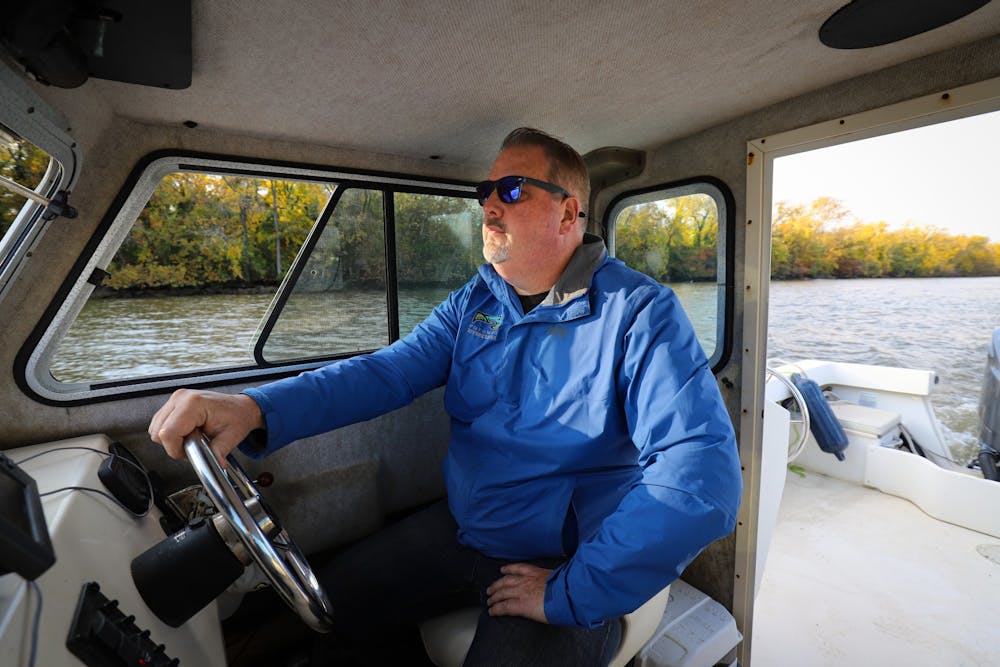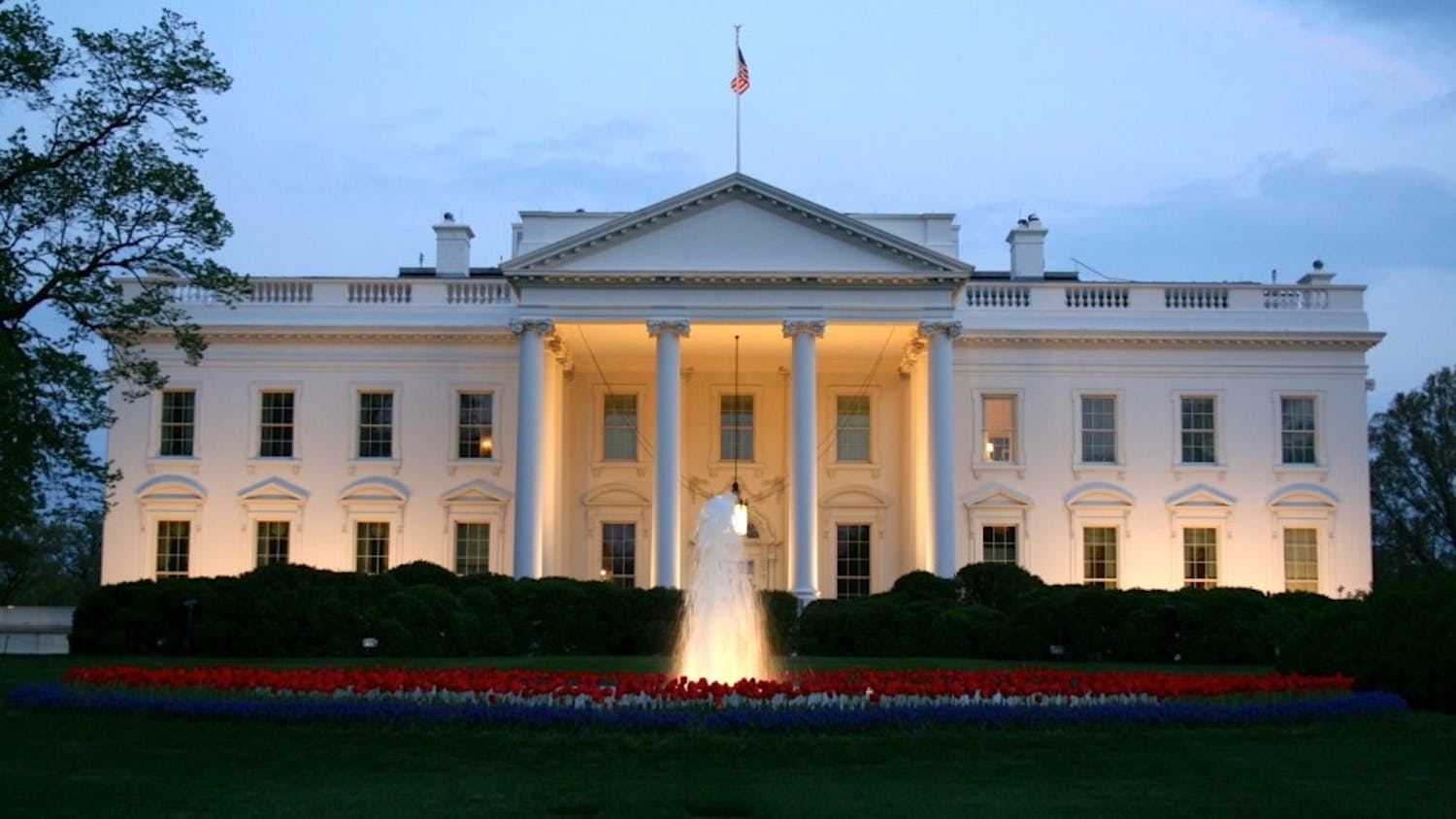On a warm Wednesday in late October, Dean Naujoks guided the smaller of his two boats out of the Washington Sailing Marina and onto the river he has devoted the past eight years of his life to protecting.
As the Lower Potomac riverkeeper, Naujoks is responsible for patrolling the Potomac from where the Shenandoah River flows into it, in Harper’s Ferry, West Virginia, to where it feeds into the Chesapeake Bay, 175 miles to the southeast.
The Potomac Riverkeeper Network, or PRKN, is a D.C.-based nonprofit that works to prevent pollution on the Potomac and Shenandoah rivers. The organization has three riverkeepers: Mark Frondorf, the Shenandoah riverkeeper; Brent Walls, the Upper Potomac riverkeeper; and Naujoks.
The job of a riverkeeper, Naujoks said in an interview on his boat that day in October, is rather straightforward: “finding sources of pollution and eliminating sources of pollution.”
Naujoks is at home on the water. He prefers talking about his work while he’s on the boat, he said, because “whenever I’m talking about myself, I’m really talking about the river.”
Before coming to D.C., Naujoks spent 14 years defending waterways in North Carolina. He served as the first riverkeeper on two rivers there and earned the River Network’s National River Heroes Award in 2009, in part for his efforts to engage the public in monitoring water quality laws at construction sites.
Naujoks moved north to join PRKN as the Lower Potomac riverkeeper in 2015. Being in D.C., he said, gives him an extra sense of responsibility.
“It’s the nation’s river, and I don’t take it lightly,” Naujoks said.
The backbone of PRKN’s work is the Clean Water Act, the United States’ flagship federal law governing water pollution. The organization uses the Clean Water Act to file lawsuits — or threaten to file lawsuits — against polluters on the Potomac and Shenandoah rivers.
PRKN has anywhere from 12 to 25 legal cases on its docket each year, Naujoks said.
“We conduct all our investigations as if we’re going to trial,” he said. But often just a notice of intent to sue is enough to get the problem fixed. “We have the science and the law on our side.”
The riverkeepers’ relationship with the Clean Water Act is a reciprocal one. Riverkeepers use its provisions to take action against polluters, and as a result they are on the front lines of enforcing one of the nation’s premier environmental laws.
But the law is under threat. A case currently in front of the Supreme Court seeks to scale back the definition of “waters of the United States,” the legal term used to determine which wetlands and streams are protected under the Clean Water Act. If the challenge is successful, PRKN could lose one of its key tools for eliminating pollution in the watersheds feeding the Potomac and Shenandoah rivers.
“I’m definitely concerned about what the Supreme Court might do to strip protections for all Americans to access clean water,” Naujoks said.
And if the court’s ruling restricts PRKN’s ability to sue polluters, it’s unlikely any other branch of government will pick up the slack, Naujoks said.
“Agencies allow us to do their job for them,” he said. Still, he’s familiar with finding workarounds when the government is unable — or unwilling — to help.
“During the Trump era, we didn’t have an Environmental Protection Agency,” Naujoks said, referencing the host of clean water regulations the EPA rolled back under the Trump administration. “We had to do it all on our own, and we did it.”
Each day looks different on the river. Identifying sources of pollution requires a variety of techniques and tools, from canoes to drones to a laboratory on a 42-foot boat called the Sea Dog docked at National Harbor.
Since 2019, the lab has been testing water samples to help PRKN better understand where river pollution comes from and how it can be stopped.
“When you place a boat like the Sea Dog on the Potomac and you equip it as a lab, it really makes a statement,” said Lisa Wu, the lab manager. “It says we’re investing in this community, we're providing for its defense. This is a struggle that really goes to the soul of our country — that everyone deserves access to clean water to drink, to recreate in, to reflect, to recharge.”
Wu, like all of the lab workers, is a volunteer. Building community through science, she said, is central to what they do. “I've met so many people who really see a connection between the people around them, their colleagues, and finding solutions to environmental problems,” she said.
The riverkeepers also watch the water from the sky. Walls, the Upper Potomac riverkeeper, has led an initiative to boost the use of drones in conservation. While a small plane used to be necessary to check out a potentially polluted site from above, all three of PRKN’s riverkeepers now have a drone. The drones save PRKN huge sums of money that would have otherwise gone to paying for pilots and fuel.
“With the drone, I can quickly and easily fly it up, investigate with the eyes in the sky, and try and figure out what kind of problem I’m dealing with,” Walls said.
In addition to his work on the Potomac, Walls teaches a class at Hood College in Frederick, Maryland, on how to fly a drone for environmental purposes and pass the Federal Aviation Administration commercial license test.
Over the last several years, efforts to reduce pollution on the Potomac have made “slow and steady progress,” Naujoks said.
An extensive project to revamp parts of D.C.’s sewer system by 2030 with a variety of infrastructure improvements is expected to greatly reduce the risk of sewage spills into the river.
And already, upgrades to wastewater treatment plants are “taking a huge amount of pollution out of the river,” Walls said.
Some boaters who have been on the river for decades recall when their motors used to get stuck in aquatic grass beds, he said. As the river became polluted and the grasses died off, boating became easier. But now, with river health rebounding in some places, those grasses are making a comeback. With them are complaints about motors getting caught in the grass. “And I’m like, ‘Well, that’s a good thing,’” Walls said.
Being a riverkeeper is at times a thankless job, but Naujoks found himself unexpectedly in the spotlight earlier this year. His moment of fame came at the end of summer, when the singer Lorde told the crowd at her D.C. concert that she went for a swim in the Potomac. After her comment was initially met with ridicule on social media, some people started asking: just how dirty is the Potomac, really?
In addition to being an investigator and defender of the river, Naujoks is a fierce advocate for swimming in it — under certain conditions. He told DCist in the aftermath of Lorde’s admission that “it was a great weekend for swimming,” and that, in fact, he took a dip in the river that weekend, too.
Swimming in the D.C. section of the river is technically illegal, but “just cause it’s illegal to swim, doesn’t mean people aren’t going in the water,” Naujoks said.
He recommended using the free app Swim Guide to check water quality before diving in. The app shows recent bacteria levels in different places along the river, based on samples collected by PRKN volunteers and tested on the Sea Dog.
The last three years of that data were compiled into the Swimmable Potomac Report 2022, which details several aspects of the river’s health, including E. coli, pH level and water temperature at 20 different sites.
Between 2019 and 2021, the sites passed public health inspections an average of 76 percent of the time, the report says.
“We want to dispel the myth that this river is polluted and dirty,” Naujoks said. “I swim in the river, and I want everyone to be able to swim in it. Just check the app first.”





